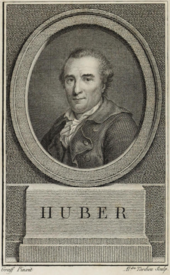
Michael Huber (27 September 1727 – 15 April 1804) was a German writer, translator and art expert. Born in Bavaria, he moved to Paris as a young man, where he probably worked as a language teacher. In the 1750s, he became a contributor to a French literary journal presenting foreign literature and started translating; his successful translations of the works of the Swiss poet Salomon Gessner into French were instrumental in popularising Gessner's works outside German-speaking areas. Huber also published an anthology of German poetry in French, with an introduction that separated German literary history into four distinct eras and was also translated into German.
In 1766, Huber, his French wife Anna-Louise and their only surviving child, Ludwig Ferdinand Huber, moved to Leipzig. Huber became teacher of French at the University of Leipzig, but as a Catholic could not obtain a formal chair at the Protestant university. He continued to translate German works into French, but was also interested in art history and had a collection of copper engravings that he used for teaching. He translated Johann Joachim Winckelmann's 1764 History of Art in Antiquity into French, edited several collections of engravings and wrote a nine-volume history of engravings that included a general theory of art.